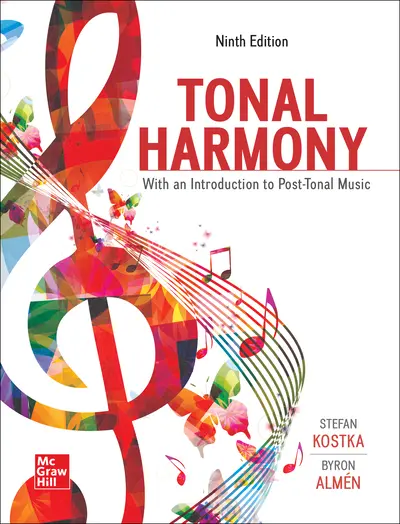My Account Details

ISBN10: 1265307350 | ISBN13: 9781265307356

* The estimated amount of time this product will be on the market is based on a number of factors, including faculty input to instructional design and the prior revision cycle and updates to academic research-which typically results in a revision cycle ranging from every two to four years for this product. Pricing subject to change at any time.
Instructor Information
Quick Actions (Only for Validated Instructor Accounts):
Tonal Harmony with an Introduction to Post-Tonal Music is intended for a two-year course in music theory/harmony. It offers a clear and thorough introduction to the resources and practice of Western music from the seventeenth century to the present day. Its concise, one-volume format and flexible approach make the book usable in a broad range of theory curricula. For a generation of professionals in the musical community, Tonal Harmony has provided a comprehensive, yet accessible and highly practical, set of tools for understanding music. With McGraw Hill’s Connect®, students are better equipped to understand and master the vocabulary of music efficiently, allowing them to move on more quickly to advanced musical skill-building.
Chapter 1: Elements of Pitch
Chapter 2: Elements of Rhythm
Chapter 3: Introduction to Triads and Seventh Chords
Chapter 4: Diatonic Chords in Major and Minor Keys
Part II: Diatonic Triads
Chapter 5: Principles of Voice Leading
Chapter 6: Root Position Part Writing
Chapter 7: Harmonic Progression and the Sequence
Chapter 8: Triads in First Inversion
Chapter 9: Triads in Second Inversion
Chapter 10: Cadences, Phrases, Periods, and Sentences
Chapter 11: Two-Part Tonal Counterpoint
Chapter 12: Nonchord Tones 1
Chapter 13: Nonchord Tones 2
Part III: Diatonic Seventh Chords
Chapter 14: The V7 Chord
Chapter 15: Other Diatonic Seventh Chords
Part IV: Chromaticism
Chapter 16: Secondary Functions 1
Chapter 17: Secondary Functions 2
Chapter 18: Modulations Using Diatonic Common Chords
Chapter 19: Some Other Modulatory Techniques
Chapter 20: Larger Forms
Part V: Chromaticism 2
Chapter 21: Mode Mixture and the Neapolitan
Chapter 22: Augmented Sixth Chords
Chapter 23: Enharmonic Spellings and Enharmonic Modulations
Chapter 24: Further Elements of the Harmonic Vocabulary
Chapter 25: Tonal Harmony in the Late Nineteenth Century
Part VI: An Introduction to Twentieth-Century Music
Chapter 26: Materials and Techniques
Chapter 27: Post-Tonal Theory
Chapter 28: New Directions
Need support? We're here to help - Get real-world support and resources every step of the way.